| Manufacturer: | Sunward Aerospace  |

(Contributed - by Kelo Waivio)
Brief:
I received the Desert Fox kit in good condition with all parts accounted for.
The kit is nicely packaged with a nice color photo of the finished model in a
desert like color scheme. The balsa parts are all nicely laser cut, the tube is
equivalent to an Estes BT56, and is glassine coated kraft paper. The centering
rings are wound paper and the plastic nose cone features a molded in canopy.
The 18 inch parachute is plastic with a printed pattern. The instructions are
well illustrated and plentiful. There are two card stock sheets with the body
wraps and a small decal sheet. There is no skill level listed on the kit.
Recommended engines are B6-2, B6-4, and C6-5 with the B6-2 being recommended
for the first flight.

Construction:
I read through the instructions and all appeared to be straightforward. I began
with the intention to follow the instructions exactly. Being primarily a
scratch-builder this took a little discipline. The first things I noticed
before construction began was the nice job on the laser cutting of the fins and
the molded in cockpit on the nose cone. Nice touch for a fighter type kit. The
decals were also a pleasant surprise. They feature Canadian Air Force as well
as U.S.A.F. and R.A.F. markings plus a logo featuring a fox wearing flight
goggles. There aren’t a lot of them but they are a nice feature.
Once I started I was disappointed to find the centering rings were too small on the outside diameter and too large on the inside diameter. I fixed this by building up the outside of the rings with strips of tape and Tite-Bond. I also used appropriately cut paper strips to build up the motor mount tube to get a good fit inside the centering rings. I have since been informed this problem has been corrected.
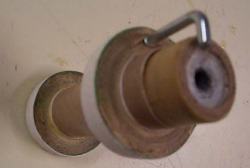 I also found the nose cone fit the tube
very tight. I left the nose cone in the tube end for several days and the tube
did relax on the shoulder a bit.
I also found the nose cone fit the tube
very tight. I left the nose cone in the tube end for several days and the tube
did relax on the shoulder a bit.
The engine hook is a little different from what I’ve seen. It’s similar to a screw eye, but is "L" shaped and is screwed into the rear centering ring. I have a few doubts about this method. It should hold up, but to get the engine in you have to rotate the L. I also found the centering ring bulged some, even though I drilled a small pilot hole for it. If I were going to build another one I would make a more conventional hook from a length of 1/32" music wire.
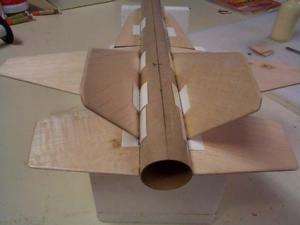 I rounded off the wings and
rudder edges and proceeded to glue them up. I did find the fit between the wing
leading edge extensions and the rear stabilizer was not what I figured it would
be. There are gaps between them that with laser cutting, just shouldn’t be
a problem. I filled the small gaps with filler and the large gap with a scrap
of balsa. All the balsa surfaces are given small paper tabs for reinforcement
except for the lower rudder. I installed them all but found out later on that
the lower tabs on the leading edge extensions are visible after installing the
body wraps. I would leave these two tabs off, as I feel they detract from the
final appearance and the upper tabs should add more than enough strength.
I rounded off the wings and
rudder edges and proceeded to glue them up. I did find the fit between the wing
leading edge extensions and the rear stabilizer was not what I figured it would
be. There are gaps between them that with laser cutting, just shouldn’t be
a problem. I filled the small gaps with filler and the large gap with a scrap
of balsa. All the balsa surfaces are given small paper tabs for reinforcement
except for the lower rudder. I installed them all but found out later on that
the lower tabs on the leading edge extensions are visible after installing the
body wraps. I would leave these two tabs off, as I feel they detract from the
final appearance and the upper tabs should add more than enough strength.
The two main body wraps gave me trouble. They are rather difficult to get to glued down and position. They did not want to stay down. Tape would help, but be sure to use some very low stick masking tape so you don’t screw up the paper wrap’s surface. The instructions call for installing the main rudders then the top fairing. The rudders are obviously glued in at an angle, but no angle is given, other than a visual reference on the kit packaging. I then found it next to impossible to fit the top fairing over the rudders. The instructions say to squeeze the rudders together, but I broke one doing this and had to cut a new one. I would highly recommend that the rudders be glued in after installing the top fairing. The instructions call for this method for the lower rudders. There are also cover strips to cover over the holes in the fairs for the rudders. Be careful to fit them over the leading and trailing edges or they’ll detract from the final finish.
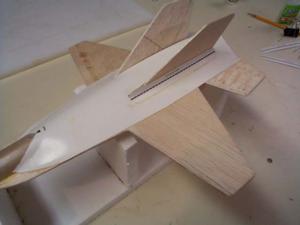
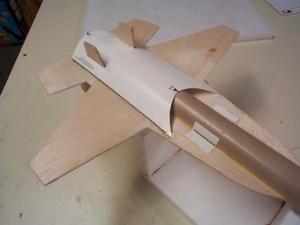
 I ended up filling the joints between the
paper wraps and the balsa with wood filler to smooth the edges. It was more
difficult to fill the gaps around the lower rudders. These joint lines between
the balsa, body tube and the wraps and reinforcement tabs is one of the things
I wasn’t too happy with as I was finishing the model. Filling the gaps
didn’t really work as I had hoped. I’m not sure what else can be done
with it, so I guess it’s best to just leave them there. (Make sure the
edges are thoroughly stuck down to the body wraps. Mine separated at a few
spots during painting.)
I ended up filling the joints between the
paper wraps and the balsa with wood filler to smooth the edges. It was more
difficult to fill the gaps around the lower rudders. These joint lines between
the balsa, body tube and the wraps and reinforcement tabs is one of the things
I wasn’t too happy with as I was finishing the model. Filling the gaps
didn’t really work as I had hoped. I’m not sure what else can be done
with it, so I guess it’s best to just leave them there. (Make sure the
edges are thoroughly stuck down to the body wraps. Mine separated at a few
spots during painting.)
The shock cord mount is the old paper 3-fold over type. I elected to use this mount, but replaced the short rubber cord supplied with a longer braided elastic cord. I assembled the chute per instructions, but added a swivel for attaching it to the nose cone. I also attached the launch lug farther up in the center of the main wing and body tube joint. This should bring it closer to the finial CG of the model and it also hides it better.
I prepped the model by giving the balsa and sanded paper around the filler a couple of coats of urethane varnish and lightly sanded it. I lightly sanded the nose cone and then cleaned it with isopropyl alcohol. I started with two coats of Painter’s Touch gray primer. I liked the desert tan camouflage pattern depicted in the kit but I think it would blend in too well with the grass and weeds at our section’s flying field. I decided on a camouflage pattern of grays and blues. I used Krylon Pewter Gray on the undersides. The upper surfaces were done in Krylon Smoke Gray base followed with Colonial Blue on top. The rear open area of the body wraps and motor tube were painted Testors flat black. The canopy was masked off and painted gloss black.
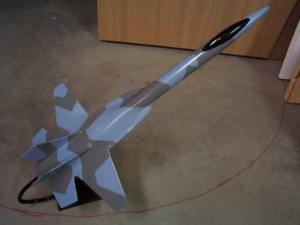
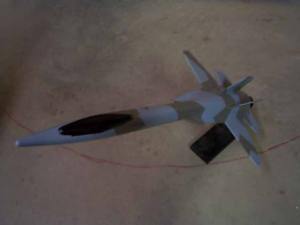
When I removed the masking tape from the nose cone I found the paint peeled off a small section on the undersides. After masking the canopy off, painting and then removing the masking tape much of the paint peeled right off like it was part of the tape. I used low tack painter’s tape and it was only left on for a couple hours while the paint dried. I went back and re-read the instructions. It says to use "polyethylene safe paint" on the nose cone. I guess I don’t know what paints are polyethylene safe. I have used the Painter’s Touch without problems on other large nose cones without problem, but have never seen anything like this. I have re-sanded the entire cone more thoroughly and re-cleaned it in dish soap and then followed it with a cleaning with alcohol. The paint seemed to take fine to every other surface. I peeled off the rest of the paint and thoroughly sanded the whole nose cone with 220 grit paper and re-did all the painting. This so far seems to be staying put. (photo 9 & 10)
I was re-reading the final pre-flight instructions for the Desert Fox. The manufacturers recommend swing testing the rocket prior to flight. I would’ve figured that there wouldn’t be a problem with stability. I added a marble sized chunk of clay to the nose cone and packed it in place with a dowel. The rocket balances about 1 ¼" from the from of the lower body wrap.
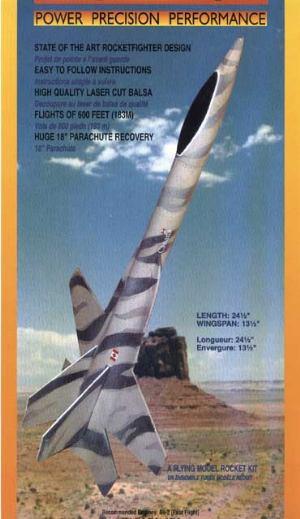 Flight report:
Flight report:
I took the Desert out to our section’s launch on April 22nd. I loaded it
up with the recommended first flight motor, a B6-2. It boosted slow and
straight to about 50 feet. Good thing it was a B6-2 and not a B6-4 as I was
planning on at first. The chute did deploy in time. I would’ve thought
this bird would’ve flew better on a B6. Maybe I just had a wimpy motor. I
launched it again on a C6-5. This flight was nice and straight to maybe 200
feet. Ejection was just past apogee. The chute got tangled on the rudders, not
uncommon for a model like this. There was no damage. The folks that saw it
thought it was a very cool design.
I would have to classify this kit as somewhat difficult due to the body wraps. On a scale of 1 to 5, I would rate this kit as a skill level 3+
Plusses:
Interesting futuristic design
Nose cone with molded in canopy
Printed chute
Good instructions
Laser cut balsa
Decals
Good packaging
Good quality balsa
Minuses:
Centering ring fit (supposed to be fixed now)
Assembly for rudders needs to be altered or clarified.
Nose cone not paint friendly
Body wraps difficult to position
No skill level listed on the kit packaging
 |
 |
Flights
 |
 |
D.R. (November 26, 2001)
Sponsored Ads
 |
 |












D.J.D. (November 21, 2001)